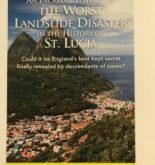
I was a bit taken aback when I received a flyer from the Ministry of Equity, Social Justice, and Empowerment and the Community Development Officer for Vieux Fort (North & South) calling the Vieux Fort South Community to a meeting to discuss social issues impacting Vieux Fort and the establishment of a Vieux Fort Development Committee. Off course, the meeting was obviously a kneejerk reaction to the recent spate of gang warfare in Vieux Fort that initially left seven dead.
I couldn’t help but think: isn’t this a bit too little, too late? Is this what is needed at this time? A bandage to appease Vieux Fortians, to give the semblance that the government is sincerely addressing Vieux Fort’s problems, that the community development officer is on the ball, helping to jumpstart socioeconomic development in Vieux Fort? Another talk shop to rehash what has already been chewed upon one too many times, as if Vieux Fortians themselves haven’t already dwelled upon, analyzed, narrated, and documented the socioeconomic issues confronting their community, and presented development proposals to their prime minister and district rep. As if Vieux Fort and Vieux Fortians have a shortage of development plans and ideas. As if Vieux Fort is at ground zero. Is this yet another swipe at Vieux Fort, I wondered, designed to amount to nothing except to allow central authority to say we tried, but what can you do with Vieux Fortians, they are a hard nut to crack?
Sometime ago the same community development officer who is now inviting Vieux Fortians to a meeting to discuss socioeconomic issues, Facebooked me asking whether there was a development plan for Vieux Fort. I told him there were several and directed him to the Jako Productions website where most of the plans are archived. I told him to take a look at the development plans and then let’s discuss some more.
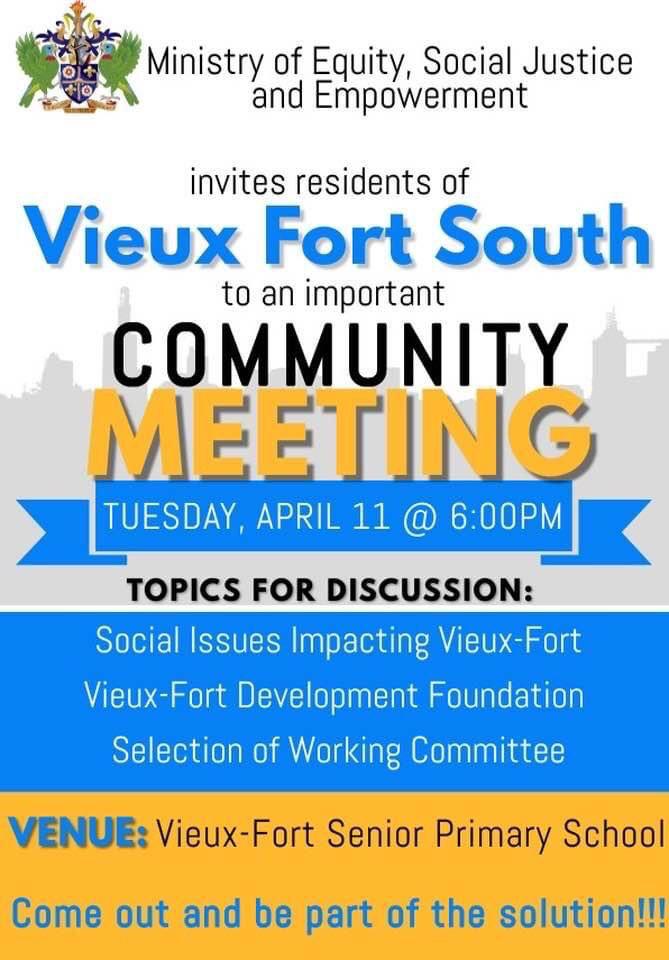
He didn’t bother to take a look, instead he asked, “but was there any holistic development plan developed for Vieux-Fort?”
I said, “I don’t know what is a holistic development plan.”
He said, “A plan which includes the address of all issues inclusive of social, environmental, economic, infrastructural, education, health, natural resource management and security and safety.”
I said, “Send an example of a holistic development plan so I can get a better sense of what you are talking about.”
He said, “I don’t have one that’s why I am asking, especially if it is a plan that is broader than only speaking to touristic, agricultural and other forms of economic development. The plan doesn’t only address economic development.”
I said, “Ok, not one on Vieux Fort, send me one from any other part of the world, to serve as a template, an example.”
He couldn’t furnish one. So, I said, “Then there is no such thing? You are a development officer, why don’t you develop one for Vieux Fort, be a hero.”
He said, “Lol, but if there already exist a template, I don’t want to reinvent one.”
At this point, I tuned him out as a non-serious person. One too lazy to even take the time to peruse the existing Vieux Fort development plans. He wanted someone to deposit in his lap the exact document his job required him to develop, and he wouldn’t even bother to read anything that he thought fell short.
With this thought, I said Vieux Fort just can’t do any right. If we didn’t have development plans, they would have said what’s wrong with Vieux Fortians, they can’t even produce a development plan? But we have development plans coming out every which way, so the complaint is that the plans are not holistic, even though such a plan may not exist for any country in the world. Poor Jab Vieux Fort! You just can’t win.
Indeed, one would be hard pressed to find any other part of St. Lucia that has been as well-researched and that has so many books and articles written about it, all readily available and accessible, than Vieux Fort, and most of that research and writing conducted not by outsiders but by Vieux Fortians themselves, adopted or born and raised.
In terms of books, if the development officer had cared to look, he would have found Sugar, slavery and settlement: A social history of Vieux Fort St. Lucia, from the Amerindians to the present, by Dr. Jolien Harmsen, an adopted Vieux Fortian; and Rum Justice, a crime, mystery novel set in the Vieux Fort area, also by Dr. Jolien Harmsen. He could not have failed to discover, The Stall Keeper, a novel by Dr. Anderson Reynolds, a born and raised Vieux Fortian, set in Vieux Fort, using the American World War II occupation of the town as backdrop, that, besides dwelling on the history of Vieux Fort, seeks to characterize the town, give a sense of why Vieux Fort and Vieux Fortians are the way they are. And how about the three poetry collections— Phases, Theatre of the Mind, and Lesson on Wings—by award-winning poet, Modeste Downes, a quintessence Vieux Fortian, the most compelling of which are the poems on Vieux Fort, including Phases, an epic, seven-page poem that traces the history of Vieux Fort, with no parallel for any other district. Indeed, there is a growing body of Vieux Fort literature that includes three books by Dr. Harmsen, four by Modeste Downes, one by Clive Sankardayal, and six by Dr. Reynolds, that is among the best of what the island has to offer.

How could any person, community development officer or otherwise, say they are serious about the socioeconomic development of Vieux Fort, holistic or otherwise, but refuses to read these books on Vieux Fort by Vieux Fortians. These books have to be the starting point of any serious discussion on Vieux Fort, for they dwell on the historical, geographical, and socioeconomic realities that has made Vieux Fort what it is today.
If any development officer doubts this, then I will refer him to the bank supervisor who accosted me in the parking lot of Massy off New Dock Road to gush about The Stall Keeper and to explain that before reading the novel she used to think, “What’s wrong with Vieux Fortians? They are the most difficult of all customers.” But after reading the book, she started seeing Vieux Fortains in a much different light, and she became much more understanding and at ease when serving the town’s people.
Vieux Fort Has No Shortage of Development Plans and Ideas
There is probably no other district that has had as many development plans visited upon it as has Vieux Fort, some of which by Vieux Fortians themselves. It seems every ten years Vieux Fort is visited by a new development plan. The first of these plans that comes to mind is one by Department of Planning and Physical Development that came out in late 1960s, early 1970s, which was nicknamed the Kowitchi Plan, reflecting the name of the principal architect of the plan. This plan was followed by the 1997 NDC plan that presented a “detailed comprehensive land use development plan” for Vieux Fort.
Then in 2008, the government dreamed up the national quadrant plan in which for the purposes of devising development plans for each district, the island was divided into quadrants. Full-colored, with wonderful depictions of what currently existed and impressions of what could be, the quadrant plan was a thing of beauty. As part of the Southern Quadrant, the development plan for Vieux Fort envisioned beach, water front, marina and cruise port development; tourism, commercial, agricultural and industrial development; convention center hotel and cultural development; residential and school expansion and airport redevelopment; and recreation, environmental and nature preservation considerations. One would have been hard pressed to conjure a more comprehensive, or using the words of our community development officer, a more “holistic plan” for Vieux Fort.
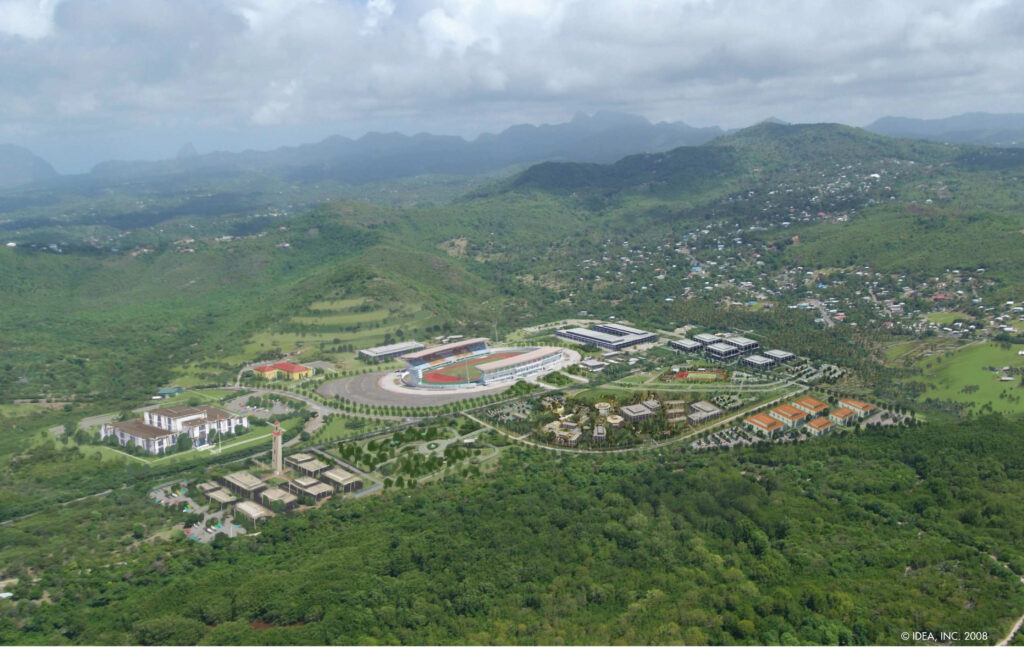
More recently, for the purposes of attracting foreign investment, Invest St. Lucia divided government-owned lands into strategic and nonstrategic assets, where the strategic land assets would be made available to developers (ideally foreign developers) for development. Seven of the fifteen strategic assets, which Invest St. Lucia calls asset portfolios, are located in the Vieux Fort area, and are the cornerstone of Invest St. Lucia’s masterplan for the district. Leaving nothing to chance, and borrowing from the Southern Quadrant Plan, Invest St. Lucia’s Plan presents enticing simulations of the development potential of its Vieux Fort asset portfolios.
In 1998, with the support and blessings of government, Vieux Fort residents established the Southern Tourism Development Corporation (STDC) as a non-profit, membership based, private organization with the mission to stimulate and coordinate the development of tourism in the south of St. Lucia, stretching from Praslin to Choiseul. Between STDC, CANARI (Caribbean Natural Resources Institute) and the National Trust a tremendous amount of well-documented work and research was conducted on the touristic development of Vieux Fort and the South, and on the conservation and enhancement of Vieux Fort’s natural assets with a view towards sustainable use.
Besides hosting economic development symposiums attended by the business community, relevant ministries, technocrats and the general public, STDC has presented position papers and detailed plans for tourism development in Vieux Fort, proposals and rationale for a Vieux Fort Marina, and position papers on the value of restoring and preserving Vieux Fort’s natural assets, including Pointe Sable Beach and the Pointe Sable recreation park.
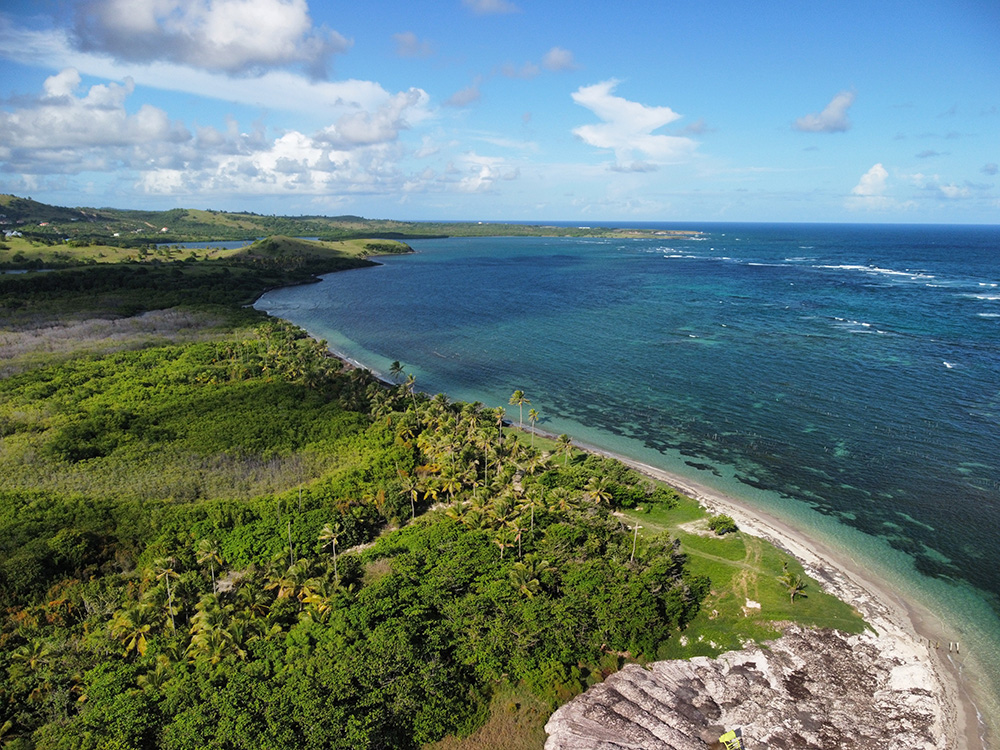
In 2007, under the management of the National Trust, Vieux Fort’s Atlantic coastal strip stretching from Moule A Chique to Savannes Bay (a four square mile area) and inclusive of the Maria Islets was designated an environmental protection area, the Pointe Sables Environmental Protection Area (PSEPA). Commissioned by the National Trust and the OECS, in 2010 Sylvester Clauzel, who recently published The Caring Entrepreneur: A Strategy for Sustainable Community-Based Tourism, presented a sustainable livelihood use plan for the PSEPA.
If all these development plans and proposals were too lame, too tame for our community development officer, then how about the Desert Star Holdings (DSH) US$3.0 billion Vieux Fort development initiative in which a Hong Kong based equine management and investment company would transform over 700 acres of Vieux Fort lands into what was called The Pearl of the Caribbean that promised a marina, a horse racecourse, resort hotels, luxury villas and apartments, a shopping mall complex, a casino, a board walk and museum in the mangrove forest, and high-rise hotels on artificial, Dubai-like palm islands off Vieux Fort’s Atlantic coast. Clearly, The Pearl of the Caribbean would be tantamount to depositing overnight a whole city on Vieux Fort’s seaboard and turning the area into a Dubai and Miami Beach replica rolled into one.
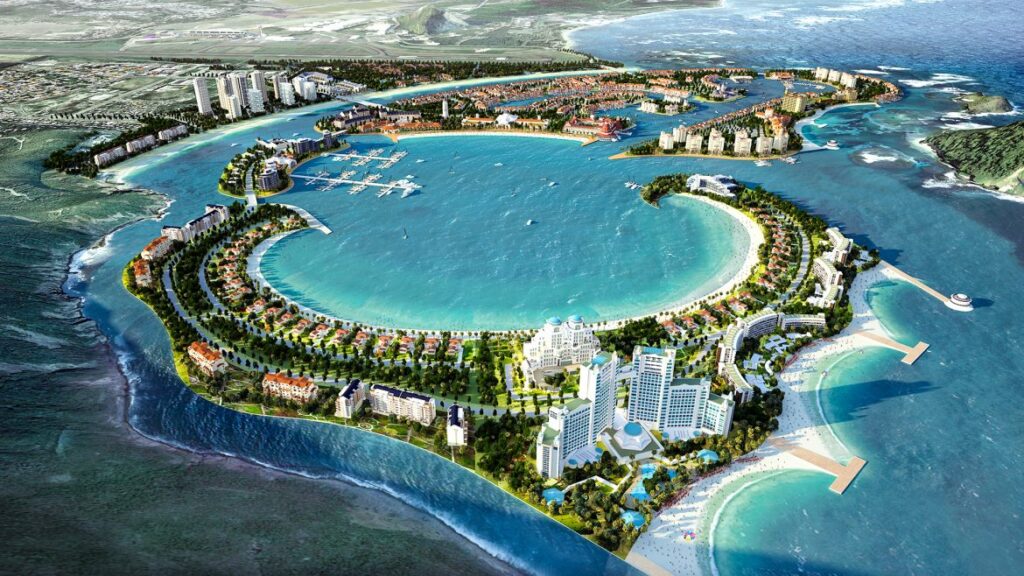
And as recently as 2017, inspired by “Think Globally, Act Locally” and the United Nations 2030 Agenda for Sustainable Develop, and as a counter development strategy to DSH, Vieux Fort hosted a symposium on a development vision for Vieux Fort, Vision 2030 Vieux Fort, at which invited speakers discussed (and/or proposed) various facets of Vieux Fort development, including medical tourism, marina and yachting development, urban redevelopment, port and seaport development, the governance of Vieux Fort, and equine, livestock and agricultural development.
Interestingly, for years and long before DSH, Gems of St. Lucia, which is headed by Wilson Jn Baptiste, a born and raised Vieux Fortian, has been proposing to successive St. Lucian administrations a development plan for Vieux Fort that included a Solar Desalination Plant, a resort hotel, a Tourism Village, and a youth development and agricultural project. However, his plea fell on deaf ears even though he didn’t require funding from St. Lucia and all he was requesting from government was its blessing and the requisite land. They refused to take a chance on a son of the soil, but received with open arms such foreign entities as Cabot and DSH, which some observers have characterized as pure land speculation schemes. If they are correct, it means we does give away our patrimony to foreigners for next to nothing which they turn around and sell for millions, if not billions, of dollars. Ministry of Justice, where is the justice in that?

What’s Wrong with Vieux Fort?
The Ministry of Equity, Social Justice, and Empowerment called for a meeting to discuss social issues impacting Vieux Fort. Ironically, the name of the ministry, “equity,” “social justice,” and “empowerment” represents the opposite that has happened in Vieux Fort over the years, so therein may lie the genesis of Vieux Fort’s social problems. Notwithstanding, as hinted above, if the ministry had cared to look, it would have found plenty of material throwing light on Vieux Fort’s socioeconomic predicament.
For example, besides the books mentioned above, such well-developed articles like Who Run’s Vieux Fort, and The Pearl of the Caribbean explain how Vieux Fort has been a victim of its geography, how it has suffered from landlessness, governmental neglect and exploitation; and how the district has paid a very high cost for facilitating national imperatives. Another paper, The Taming of Vieux Fort, speaks to the environmental degradation of the district and the disappearance and haphazard use of its lands.
Shantytown, renamed Bruceville, is one of the most socioeconomically depressed parts of St. Lucia, a theatre of Vieux Fort’s bloody gun warfare, home to some of the districts most notorious drug lords. The paper, The Making of Shantytown, places Bruceville in historical, geographical, political and socioeconomic perspective and encapsulates most of the issues that have kept Vieux Fort from realizing its true potential. So, in terms of the social issues impacting Vieux Fort, in terms of “equity,” “social justice,” “empowerment,” or the lack there of, the Ministry may want to start with The Making of Shantytown.
And before anyone should jump up and say that Vieux Fortians waiting for other people to speak for them or to analyze their situation, note that all of these papers were written by Vieux Fortians. And before anyone should say they don’t know where to access these articles, note all of them are readily available on the website of Jako Productions, a homegrown Vieux Fort establishment. And if any one is tempted to fall back on the stereotype notion that Vieux Fortians are lazy, and hence the source of Vieux Fort’s socioeconomic woes, then I would like to invite them to view the seventh episode of Conversations with Dr. Anderson Reynolds in which two Vieux Fortians debunked all such prejudices and stereotypes of Vieux Fort.
A Marshall Plan For Vieux Fort
World War II left Europe in ruins and devastation and looming famine. So in 1948 President Truman legislated an European economic recovery plan named the Marshal Plan after Secretary of State George Marshall who first proposed the initiative. Under the Marshall Plan, the US contributed $13.3 billion towards Europe’s economic reconstruction, which greatly speeded up the continent’s recovery.
Before World War II, in the decade of 1929-1939, the US as well as the rest of the world had its share of economic misery. Following an October 1929 Wall Street stock market crash, the world plummeted into deep economic depression. World gross domestic product (GDP) contracted by about 15 percent, world trade declined by over 50 percent, and US unemployment rose from 3.4% in 1929 to 24.9% in 1933.
President Franklin D. Roosevelt reckoned that nothing less than a restructuring of the US economy would be needed to induce a speedy return to normalcy and to prevent future economic depressions. Thus, the president made sweeping changes to the American economy with the introduction of banking, monetary and securities reforms, poverty relief programs, massive public work projects, and housing, farm and rural programs. Collectively the reforms and programs were referred to as the New Deal. Thanks in part to the New Deal, by 1937 the US economy had all but returned to normal.
World War II had finally ended with the surrender of Japan after the US atomic bombing of the Japanese cities of Hiroshima and Nagasaki that killed between 129,000 and 226,000 people, most of whom civilians. The war had visited upon Japan probably just as much devastation as it had on some European countries. However, the US post-war involvement in Japanese society and economy was much more extensive than in Europe. For the next seven years (1945-1952), US occupying forces decreed widespread military, political, economic, and social reforms on Japan.
The time for meetings with disinterested, powerless ministry officials and community development officers has passed. The time for the establishment of ill-funded, politically skewed, toothless so-called development foundations have passed. The time for appearances and niceties, and seeming to do the right things has passed. The time for piecemeal initiatives geared more to appeasing constituencies and creating jobs for party supporters than to once and for all solve the nation’s problem has passed. The time for kneejerk reactions has passed. Vieux Fort needs nothing less than a Marshall Plan, A New Deal.
Vieux Fort Needs Heroes Not Villains
Like the Great Depression, Like Europe and Japan after World War II, Vieux Fort is facing a major crisis but the recent spate of gun violence is the least of it. Gangs and drug lords are just one response, one reaction, one accommodation to the crisis Vieux Fort faces. As one of the most socially and economically depressed parts of the country, Vieux Fort is faced with a socioeconomic crisis. It suffers from the nation’s highest rate of joblessness. Its 2020 unemployment rate of 33.3 percent was over 11 percentage points above the national average (Table 1). For nine of the past eleven years, its unemployment rate exceeded that of all districts, such that over that period its average annual unemployment rate of 34.4 percent was nearly 8 percentage points higher than that of Dennery with the second highest rate of joblessness.
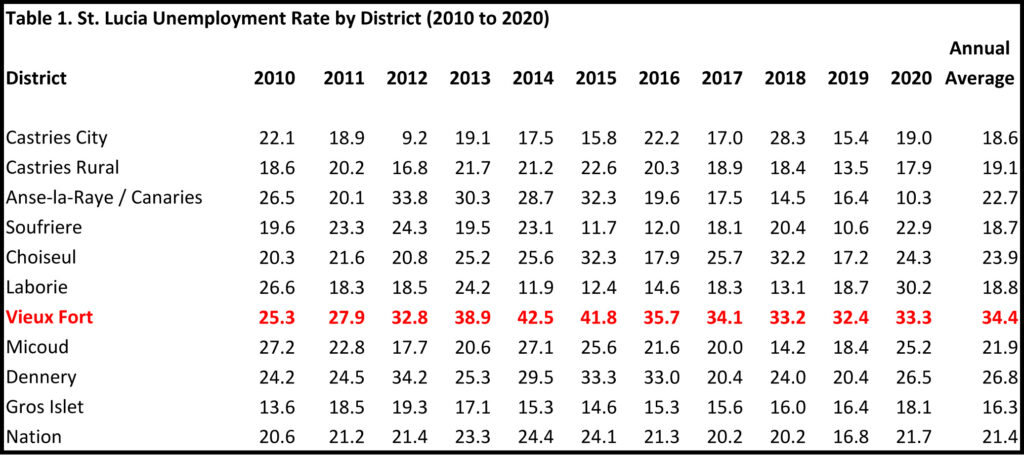
In terms of the poverty rate, Vieux Fort doesn’t fare much better. The poverty rate measures the percentage of the population whose per capita income (income per person) or per capita consumption expenditure is below the poverty line, calculated as the cost of one year’s worth of necessities (both food and non-food) for the average adult. A 2016 study analyzing living conditions in St. Lucia (Table 2), estimated the poverty line for St. Lucia in 2016 as EC $6,443. Based on this poverty measure, Vieux Fort registered a poverty rate of 34.6 percent, an increase of 11.5 percentage points from the 23.1 percent recorded in 2006, and almost 10 percentage points above the national average of 25 percent. These poverty statistics meant that Vieux Fort was the third poorest, behind Anse La Raye/Canaries (38%) and Dennery (45%), of St. Lucia’s ten districts.
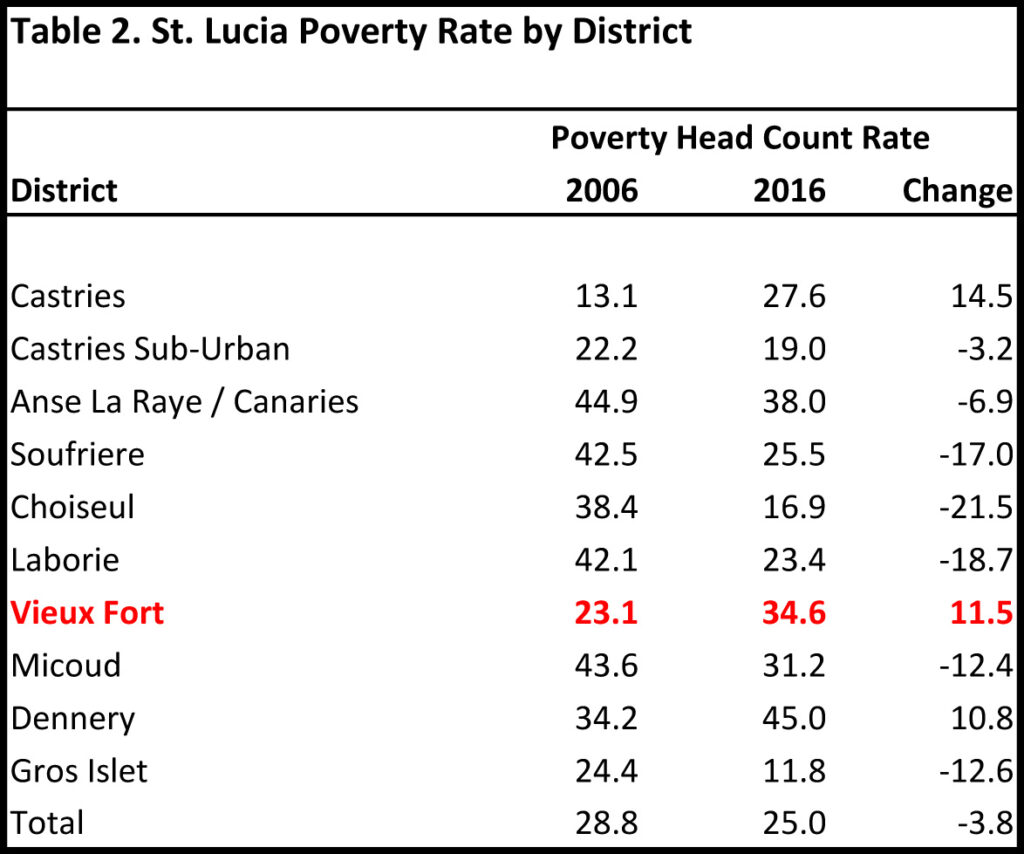
Imagine that. At its worst, the Great Depression of 1929-1939 that brought America and the World to their knees was associated with a US unemployment rate of no more that 25 percent, a world unemployment rate of 30%, and the unemployment rate of any one country never rose above 33%. Yet, in response, America saw it fit to introduce sweeping financial and economic reforms and to completely overhaul its economy.
Vieux Fort, on the other hand, faces a perennial unemployment rate of over 34 percent (and likely a youth unemployment rate of over 45%), which means the district is in a permanent state of Great Depression. But in contrast to the American response, what is the St. Lucian response? Low level Ministry of Equity, Social Justice, and Empowerment meetings to discuss social problems impacting Vieux Fort. That is like America in the aftermath of World War II sending low level state department officials to Europe and Japan to discuss the social problems impacting their country, or during the Great Depression President Roosevelt sending them to American cities to discuss social problems.
A man’s house is on fire, his wife and children and most of his worldly possession are going up in flames, yet the government is there seeking a doorstep chat with the man about why his house wasn’t painted.
The more appropriate response, it seems to me, would be a war room meeting with a war chess of US$300 million on standby to embark on a priority list of initiatives that would bring economic viability to Vieux Fort. A whole day, full scale, all hands-on deck cabinet meeting with key representatives of Vieux Fort (not the party hacks, for Vieux Fort need heroines not party hacks) to iron out the priority list and out of that meeting to unleash A Vieux Fort New Deal, a Vieux Fort Marshall Plan.
A reading of some of the books and articles mentioned earlier would reveal that it is customary to blame Vieux Fortians for the district’s socioeconomic predicament. Vieux Fortians are lazy has been the mantra, and to that has now been added Vieux Fortians are violent. But is this just an excuse to continue exploiting and neglecting the district?
As Goes Vieux Fort So Goes St. Lucia
No matter. The rationale for devising a Marshall Plan for Vieux Fort and rejuvenating its economy isn’t just about Vieux Fortians, but about the whole nation, for the district is a key cog in the national economic wheel.
Vieux Fort’s population of 16,434 (2011 estimate) accounts for about 10 percent of the country’s population and places it behind Castries and Gros Islet as the nation’s third most populous district (a position it shares with Micoud). However, since Vieux Fort serves as the commercial, industrial, and job center for the southern half of the island, in terms of national economic bearing, the more relevant statistic is the combined population of Micoud (North and South), Vieux Fort (North and South), Laborie, and Choiseul, which amounts to about 45,785 or 27% of the nation’s total. Clearly, the economic health of St. Lucia depends significantly on the economic viability of Vieux Fort.
But Vieux Fort’s importance goes beyond economics. It is home to several of the country’s key strategic assets including its only international airport and one of two of its ocean-going ports. Vieux Fort is of geopolitical significance. It is telling that the US made a comeback to Vieux Fort in the 1950’s to establish radar facilities at Morne-A-Chique and at nearby Morne Leblanc overlooking Laborie as the Cold War was picking up steam, and that the US returned again in the 1980’s during the Grenadian invasion. Some commentators have noted that, considering Vieux Fort’s topography, geographical location, and air and sea port facilities, DSH’s interest in Vieux Fort may have much to do with China’s geopolitical strategic designs.
There is a warning, lè bab kanmawad-ou pwi difé wouzé sa ou, (when your friend’s beard catch fire, wet yours) that seems applicable to the current killing wave in Vieux Fort and the nation as a whole. The recent wave of violence (and not just in Vieux Fort) suggests an increasing brazenness and escalation of violence. Suddenly, in meting death, perpetrators are unmindful of time of day, and of place, be it public places, churches, funerals, wakes. For the first time perpetrators are dispensing violence on uninvolved family members (parents and grand-parents of their enemies). There seems to be no respect of persons, places, holiness or sanctity. Maybe the only reason the killings didn’t arrive at the schools is because most of the gangsters are so young that they are yet to have school-age children. Another way in which we are lucky is that apparently the drug lords haven’t established national organizations, national networks, then the conflicts that have given rise to the Vieux Fort killing spree may have taken on national proportions, and nationally the dozen (so far) localized kills may have mushroomed to sixty.
So whoever think that what’s happening in the country is simply a Vieux Fort thing, and as per habit Vieux Fort can be disdained, neglected, and can be considered inconsequential, that is, unless it is being subjected to exploitation, then they should think again.
So for the sake of the nation, if not for the sake of Vieux Fort, we need a Vieux Fort Marshall Plan.
We are doing nothing about the conditions of decades of institutionalized unemployment and poverty and deprivation that have given rise to the crime cesspool, and we have done little to arrest the cesspool. Indeed, we have legitimized criminality, gangsterism, and drug trafficking. The drug lords are well integrated members of society; they help fund political campaigns and are recipients of government contracts. In certain Vieux Fort neighborhoods, they are the only action in town: they provide youth employment, recreation facilities, and sometimes for national celebration activities they fill the void left by legal authorities. In many ways, in these communities the drug lords are the defacto government, forcing some to say, Vieux Fort is a failed state. It would be very interesting to ascertain the extent to which drugs and money laundering are keeping the St. Lucian economy afloat. Some have even speculated that projects like DSH, La Paradis, and Cabot, besides land speculation sweet deals, are money laundering schemes.
However much mayhem our four to five dozen or so young men, most of whom too young to have school age children, are causing in Vieux Fort, we have to see them as victims. The blame falls elsewhere.
At this point a glance away to a village in the Niger River Delta region of Nigeria, on the Gulf of Guinea on the Atlantic Ocean, may throw some light on the Vieux Fort situation. Like Vieux Fort, the delta is a victim of its geography. It is rich in petroleum, which reportedly is being exploited by foreign oil companies and the national government, not necessarily for the benefit of the Delta people, but nonetheless causing environmental pollution and destruction in the region. The village in question is plagued by poverty and unsanitary conditions. Traditionally, fishing has been its main source of livelihood, but overfishing and oil spillage possibly from the drilling operations of a nearby oil company, which refuses to employ any of the villagers, has meant dwindling fish stock. So as a matter of survival, some of the men from the village have banded together into a 45-man strong pirate gang that, with speed boats and machine guns, accosts ships plying the Gulf, prepared to murder the crew if they refuse to meet their demands. As a rule, the pirates ignore the Indian and Pilipino ships because, according to them, they are too cheap, they are not worth the effort. But American and French ships are a different story. They provide the biggest payday. The gang use their spoils to buy better guns and faster speed boats and to provide for their families. The leader of the gang has five children, two of whom are attending university. It goes without saying that directly and indirectly piracy has become the lifeblood of the village.
Who is to blame?
Stay tune for Part Two of our exposition as we focus more closely on who bears the greatest blame for Vieux Fort’s current predicament, and how we can fund the Marshall Plan for Vieux Fort. And look out next year for Welcome to Vieux Fort, a book that puts Vieux Fort into historical, geographical, socioeconomic, and national and geo political perspective.
![]()

